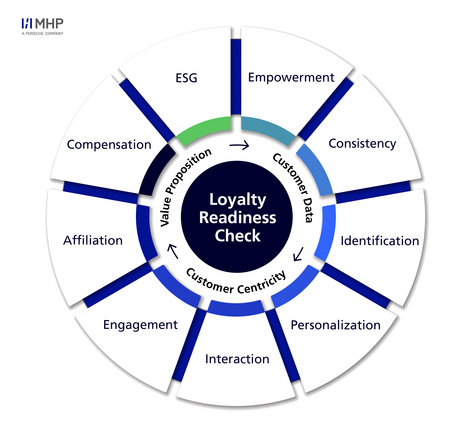
- Blog, Customer Experience & Sales
- Published on: 02.05.2024
- 7:41 mins
Green Loyalty Program: Sustainable Customer Retention with Environmentally-Aware Market Positioning
In this digital age when every second of customer interaction counts, the competition to capture customers’ attention is intense. As such, efficient customer retention is increasingly becoming the key to long-term corporate success.
Studies show that sustainability factors such as recycling programs, sourcing food locally, and environmentally-friendly measures have a crucial influence on customer retention. Furthermore, a “green image” in sectors such as telecommunications, banking and consumer goods industries can lead to a significant rise in customer loyalty.
This presents companies with the challenge of realizing effective customer retention without harming the profit margin. And this is where “green loyalty” can offer an innovative solution. The concept brings together customer retention with sustainable action.
In this article we explain how “green loyalty programs” can form the bridge between customer loyalty and environmental responsibility, and thereby enable companies to master the balancing act between growth, sustainability, and authenticity.
Setting New Standards for Customer Retention with Green Loyalty Management
Loyalty management or customer retention programs essentially combine a variety of measures intended to produce a sense of connection and attachment – they aim to positively influence the buying behavior of customers, stabilize the relationship, and expand it economically. From loyalty schemes, through customer cards to customer clubs – companies have numerous options for adapting their loyalty management to their customers. And choosing the right format is critical for the acceptance and success of the program.
In cases where sustainability is applied to existing customer retention concepts, this is termed “green loyalty”, with “green loyalty programs” being one aspect of this. We will look at these two terms more closely below:
What is Green Loyalty?
Green loyalty refers to a company’s customer retention strategies which are based on environmentally-friendly principles, promoting sustainable behavior, and strengthening entrepreneurial responsibility with regard to sustainability. This is a form of customer retention in which the company actively encourages and rewards its customers for taking environmentally-aware decisions, supporting sustainable practices, and committing to a sustainable lifestyle.
Whatever their focus, generally speaking, green loyalty programs are designed to trigger repeat purchases (more-selling), promote other products and services (cross-selling) or make customers aware of higher value offerings (upselling). The design parameters play an important role here, as they determine how attractive the program is and how it compares to others.
The Advantages of Green Loyalty Programs
Green loyalty programs can be an effective strategy for strengthening customer retention. Essentially building on environmentally-friendly principles and sustainable behavior, using benefits such as bonuses, discounts, loyalty schemes/points, or exclusive offers, they above all reward those groups of customers who take environmentally-aware decisions and to whom ecologically sustainable behavior is important. This form of customer retention can have several positive effects.
Stronger customer retention
One of the main benefits of green loyalty programs is the creation of stronger customer retention. Customers who identify with the sustainable values of a company often develop a deeper loyalty to the brand in question. This results from their personal convictions being in accord with the objectives of the company, leading to a greater emotional bond, and establishes customer loyalty in the long term.
Positive brand perception
Green loyalty programs also improve the perception of your brand. Companies that implement such programs are regarded as responsible and forward-looking. This not only strengthens the image of the brand among the public, but can also contribute to strengthening customers’ trust in the company. At a time when consumers are attaching more and more importance to the social and ecological effects of the buying decisions, a positive brand perception can give you a significant competitive edge.
Improved customer satisfaction
Another important advantage offered by green loyalty programs is increased customer satisfaction. Customers who are rewarded for environmentally-aware behavior, for instance with discounts or exclusive offers, feel valued. This not only boosts satisfaction with the company, but also motivates the customer base to continue to make environmentally-friendly decisions.
Standing out from the competition
Green loyalty programs also enable companies to stand out from the competition. In saturated markets with many competitors, a strong commitment to sustainability can be a decisive factor in convincing customers to choose a specific brand. Companies that work actively towards sustainability attract environmentally-aware customers who place increasing importance on ecological responsibility.
The Challenges of Green Loyalty Programs
Now more than ever, customer retention programs are caught between innovation and traditional approaches. For green loyalty programs in particular, the challenges are multilayered and demand a differentiated approach to address both ecological objectives and customer interests effectively. In their sustainability strategy, marketers therefore face the challenge of how to manage the balancing act between growth, sustainability, and authenticity. They have to consider the following demands when it comes to planning and realizing their sustainable loyalty strategy:
- Balancing profitability and sustainability
With green loyalty programs, companies focus firstly on their sustainability strategy, but naturally also want to increase their sales and thus profits with customer retention. There is the risk that a “green”-oriented customer retention program has ecologically valuable elements that are relevant to the target group, but at the same time promotes excessive consumption and thus increased use of resources. Authenticity and credibility
Authenticity and credibility are equally essential challenges for green loyalty programs, as consumers today are sensitive about environmental claims and quick to identify greenwashing. To guarantee authenticity, companies must ensure that their programs are based on real environmentally-friendly practices and communicate this transparently. The practices should be consistent with the general sustainability objectives of the company and offer sustainable actions that actually contribute positively to environmental protection.Adapting to different customer preferences & interests
Companies have to tailor their green loyalty programs to various customer segments, to take different values and preferences into account. This includes ensuring that the programs offer sufficient flexibility and personalization to respond to the individual needs and values of the customers.Measuring and assessing the effectiveness of green loyalty programs
Measuring and assessing the effectiveness of green loyalty programs demands a methodical approach in order to quantify their economic benefits. This includes precise analysis of additional profit generated by the program, based on clearly-defined objectives such as increasing customer loyalty and the average value of transactions. It requires comprehensive data collection and analysis relating to use of the program.
Using methods such as Uplift Modeling and analyzing performance indicators such as Net-Promoter Score and Customer Lifetime Value, you can quantify the direct influence of your green loyalty program on customer retention and corporate performance. These metrics help not just to understand the impact of the programs, but also enable continuous optimization and adjustment of the strategies to achieve the best possible results.
How MHP Can Equip Your Company for Green Loyalty
Traditional customer retention programs usually target the stability of the customer relationship. A forward-looking evolution also addresses the success factors of sustainability and growth, which can bring about a significant competitive advantage. The goal now, as in the future, is to be close to the customer base, to understand their needs and thus bring about long-term customer retention.
Experience shows that, for long-term customer retention, companies need more than just a customer retention program. The strength of the loyalty generated is especially influenced by the emotional bond, which lends itself to being enhanced by an optimal and innovative mix of functional and emotional tools.
To embed sustainability aspects in the existing customer retention strategy and program orientation, the customer retention tools must first be considered in their entirety. After all, authenticity in particular plays a major part in relation to sustainability.
Successful customer loyalty management with the MHP Loyalty Readiness Check (LRC)
The MHP Loyalty Readiness Check (LRC) allows you to scrutinize your customer retention strategy and all related activities so you can identify areas for improvement and potential for growth. The LRC is an assessment tool which can analyze the status quo of an existing customer retention program or the general openness to loyalty of your customers. Using a focused gap analysis, potential improvements in your customer loyalty program for different target groups and your company’s product portfolios can be uncovered. An example of the LRC is given below:
The following three dimensions, which reflect the interactions and influential factors mentioned above, are considered:
- Customer Data: Issues and the extent to which your customers are identifiable across all touchpoints using a unique ID and the consistency of your database are of central importance here.
- Customer Centricity: This considers among other things how homogeneous the segmentation of your loyal customers is and how appropriately customer needs are reflected.
- Value Proposition: This looks for example at the extent to which your value proposition is contemporary, authentic, comprehensible and appropriate to your customer segments.
These three dimensions embrace the functional basis as well as supplementary emotional buzz tools. From collection of consistent customer data through inspirational Omnichannel Customer Interaction, to the focused value propositions of your customer retention program, the LRC offers a broad spectrum of influential factors for customer retention.
Since sustainability is a central concern of society and is ever more important, it is gaining in significance in customers’ buying decisions. These decisions are influenced by both rational and emotional factors. By comparing the status quo with future objectives, we develop tailored recommendations for action and together create the relevant “green” design parameters.
Success Factor Green Loyalty: With the Right Strategy to Sustainable Customer Retention
The implementation of green loyalty programs is more than just a trend; it is a strategic necessity that enables your company to remain competitive in an increasingly environmentally-aware world. They not only offer a means to boost the loyalty of customers, but also enable companies to position their brands as responsible and forward-looking. The right mix of flexibility in the program design and precise measurement of success can help you use this approach effectively, to build lasting customer relationships and maintain them over the long term.
Optimize your green loyalty program and promote a sustainable future at the same time: MHP is your experienced partner for innovative and environmentally conscious customer loyalty programs.




